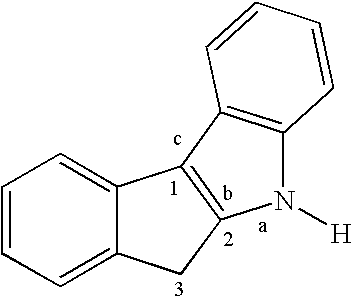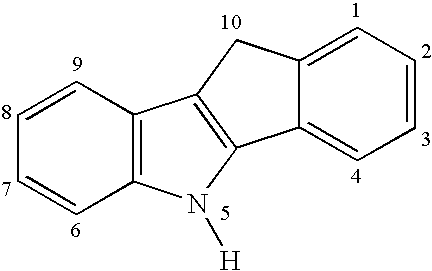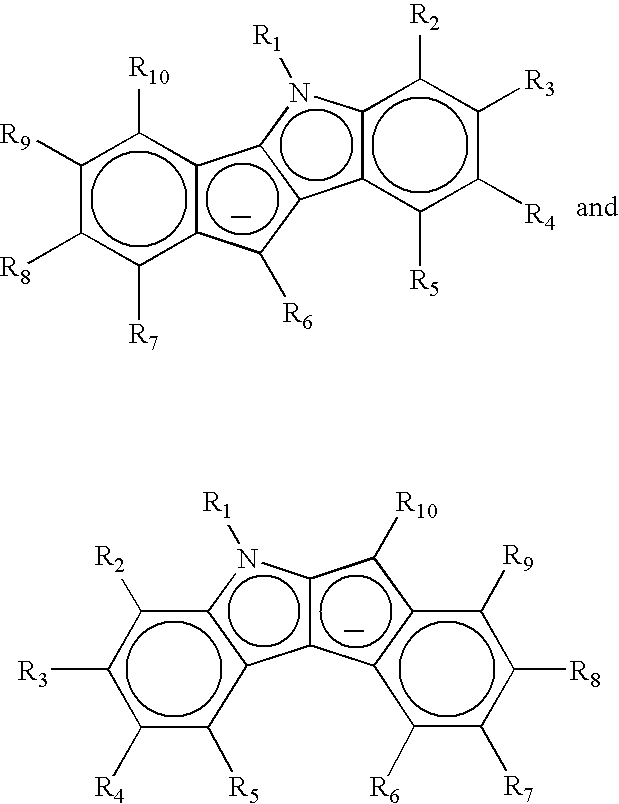Preparation of ultra high molecular weight linear low density polyethylene
- Summary
- Abstract
- Description
- Claims
- Application Information
AI Technical Summary
Benefits of technology
Problems solved by technology
Method used
Image
Examples
example 1
Preparation of Dimethylsilyl-Bridged Indeno[1,2-B]Indolyl Cyclopentadienyl Zirconium Dichloride
[0031](a) Preparation of Indeno[1,2-b]indole
[0032]1-Indanone (30.6 g, 232 mmol), p-tolylhydrazine hydrochloride (37.0 g, 233 mmol) in EtOH (350 mL), and aqueous HCl (12 N, 18 mL) are mixed and the mixture is heated to reflux for 90 min. The mixture is cooled and filtered, and the solid is washed with EtOH (600 mL) and then by 20% aqueous EtOH (400 mL), and finally by hexane (200 mL). The off-white solid is dried under vacuum (36.5 g, 72%).
(b) N-Methylation
[0033]The product from step (a) (36.5 g, 166 mmol), aqueous NaOH solution (112 mL, 20 M, 2.2 mol), C16H33NMe3Br (0.65 g, 1.78 mmol), and toluene (112 mL) are mixed with vigorous stirring at room temperature. A solution of MeI (17.0 mL, 273 mmol) in toluene (15 mL) is added to the mixture dropwise, and the mixture is then stirred at room temperature for 4 h and refluxed for 3 h. A crystalline solid forms upon cooling and is filtered and wa...
example 2
Preparation of Non-Bridged Indeno[1,2-B]Indolyl Cyclopentadienyl Zirconium Dichloride
[0038]In a glove box under nitrogen, N-methylated indeno[1,2-b]indole (14.2 g, 60.9 mmol), prepared as described in Example 1, is dissolved in toluene (175 mL). n-Butyllithium (38.0 mL of 2.5 M solution in hexanes, 95 mmol) is added carefully under vigorous stirring at room temperature to give a red solution. After one hour, a precipitate forms. The mixture is kept at room temperature overnight and is then filtered and washed with toluene (100 mL) and then with heptane (200 mL). The sticky product is dried under nitrogen in the glove box and is collected and dried under vacuum.
[0039]A sample of the indeno[1,2-b]indolyl lithium salt produced above (10 g, 42 mmol) is dissolved in toluene (95 mL) to produce an orange slurry. Diethyl ether (35 mL) is added slowly to give an orange solution. This solution is added over 15 min. at room temperature with stirring to a slurry of cyclopentadienylzirconium tri...
example 3
Preparation of MAO-Treated Silica Support
[0040](a) Calcination of Silica
[0041]Silica (CARiACT G-3 (5A), FUJI Silysia Chemical Ltd.) is calcined in an oven where the temperature is increased from room temperature to 200° C. over a 6 hr. period, held at 200° C. for an 8 hr. period, and then the temperature is reduced to room temperature over a 6 hr. period.
(b) Deposition of MAO on the Calcined Silica
[0042]In a glove box (room temperature) anhydrous toluene (50 mL) is added to the calcined silica (11.25 g) in a 250 mL Schlenk flask with a magnetic stirrer to form a slurry. Methylalumoxane (40 mL, 30% wt in toluene, product of Albemarle) is slowly added to the silica slurry while stirring for 0.5 hour. The flask is removed from the glove box and placed in an oil batch (80° C.) and stirred for 2 hours and is then cooled to room temperature. The toluene is removed by vacuum and 28.0 g of the resulting white powder is dried further by vacuum.
PUM
| Property | Measurement | Unit |
|---|---|---|
| Mass | aaaaa | aaaaa |
| Density | aaaaa | aaaaa |
| Density | aaaaa | aaaaa |
Abstract
Description
Claims
Application Information
 Login to View More
Login to View More - R&D
- Intellectual Property
- Life Sciences
- Materials
- Tech Scout
- Unparalleled Data Quality
- Higher Quality Content
- 60% Fewer Hallucinations
Browse by: Latest US Patents, China's latest patents, Technical Efficacy Thesaurus, Application Domain, Technology Topic, Popular Technical Reports.
© 2025 PatSnap. All rights reserved.Legal|Privacy policy|Modern Slavery Act Transparency Statement|Sitemap|About US| Contact US: help@patsnap.com



